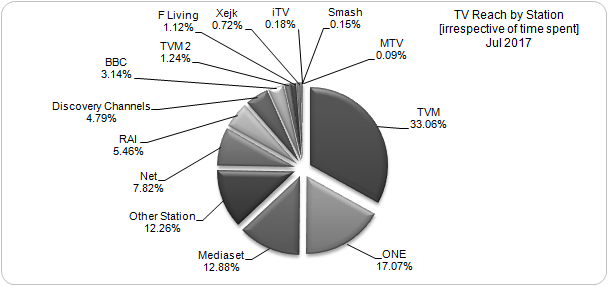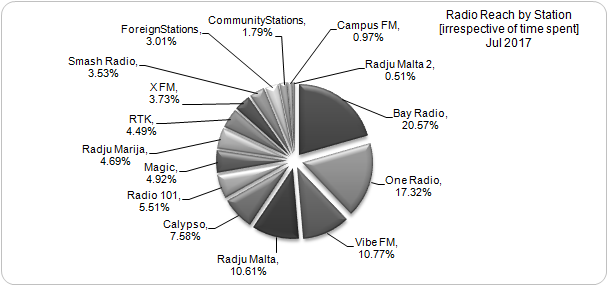Release: Immediate
Date: 1st September 2017
PR 16/17
RADIO AND TELEVISION CONSUMPTION UPHELD DURING THE BROADCASTING SEASON
The Broadcasting Authority has just released its latest study on audience assessment for July 2017.
The latest survey reveals that the average amount of hours that TV viewers spent watching television amounts to 1.57hrs every day. This was just 9’26” less than that of the previous assessment during the month of February [1.73hrs], and 13’48” less than that registered for the same period last year in July 2016 [1.80hrs].
However, over the whole population the national average for TV viewing in July stood at 0.90hrs every person. This was 0.39hrs [or 23’4”] less than the national average at February 2017 [1.29hrs]. And this means that although television viewing was upheld by regular viewers there were slightly less consumers watching television.
During the month of July an average of 191,000 persons or 51% of the population aged 16 years and over followed at least one TV station during this month, while an average of 178,000 persons [47.6%] listened to radio.
Radio listeners have spent an average of 2.91hrs listening to their radio set. Compared to the previous assessment of February 2017 [3.17hrs] this was 15’36” less and compared to that of July 2016 [3.04hrs], this year’s listening average was just 7’36” less.
Similarly, over the whole population the national average for radio listening in July stood at 1.41hrs every person. This was 0.28hrs [16’48”] less than the national average at February 2017 [1.69hrs]. Again meaning that although radio listening was upheld by regular listeners there were less persons following their radio sets.
Data was collected by the National Statistics Office during the month of July and 37.2% of all contacted persons accepted to participate. A sample of 1,240 was collected with the youngest interviewed being 16 years old while the eldest person contacted was 95 years old.
TV Audience Reach
TVM remains the most popular station with 33.1% followed by ONE [17.1%] and Net TV [7.8%]. Overall 61.4% of all viewers followed a local station while the other 38.6% followed a foreign station with Mediaset Channels [12.9%], Rai 1 [5.5%] and Discovery Channels [4.8%] being the most popular stations.
As in other previous surveys, TV audiences tend to peak between 7:30pm and 10:00pm

TV reception service
As much as 91.5% of the population follows television through a paid subscription. Almost half of the population [141.0%] has more than one service available for watching television while only 4.5% of the population [≈16,800] follows programmes on the Free-to-air platform. Of the latter group, 43.1% [≈7,200] only have a Free-to-air connection while the rest [56.9%; ≈9,600] also makes use of one or more of the services available.
The availability of multiple platforms for watching television is highest amongst the 16-30 age group [159.6%] and lowest amongst the 70+ age group [110.3%] – while more than half of all 16-30 year olds [59.6%] have at least access to two reception services only 10.3% of all 70+ year olds have access to two platforms for viewing television programmes.
TV Programme Genres
Respondents were asked what type of programme they like to watch on local television. Local and Foreign News were the most favorite programme genre [63.0%] followed by local Drama programmes [43.4%], while Discussion & Current Affairs programmes ranked third [25.8%].
In general, when analysed by gender, more females [234.4%] than males [210.6%] had preferences for the genres named. While male references exceeded those of females in just three categories – Local & Foreign News [+3.2%], Documentaries [+5.4%] and Sports [+23.4%]; female preferences exceed those of males in Drama [+26.6%], Religious programmes [+6.0%], Light Entertainment [+10.8%], Teleshopping [+5.4%], and Music Videos [+4.5%].
There was very little gender difference for Discussion programmes [±1.1%]; cultural/Educational programmes [±1.4%], and Children’s programmes [±0.2%].
Radio Audiences
Bay Radio remains the most popular station with 20.6% of all radio listeners followed by ONE Radio [17.3%] and Vibe FM [10.8%]. Bay Radio is popular with all those under the age of 50 whereas ONE Radio is popular with those who are above the age of 50.
Computing audience shares by the amount of time that radio listeners have spent following each particular station, the results reveal that while Bay Radio is the most popular station in Malta, its listeners spend an average of 1.62hrs tuned in to the station whereas ONE Radio listeners spend 4.16hrs.

DAB+
Respondents were asked whether they have a DAB+ radio set to listen to radio. Only 13.1% replied that they had a digital radio set; 80.5% does not; 3.5% of respondents did not know what kind of radio-set they had; while 2.6% replied that they do not have any radio-set whatsoever.
Just more than half [53.4%] of those who stated that they have a DAB+ radio-set replied that they only listen to local stations; another 5.4% use such radio-set to listen to only foreign stations; while a further 10.9% stated that although they have a DAB+ radio-set they do not use this set to follow radio.
Children watching TV
Out of all the respondents only 12.1% replied that they have children between 9 and 15 years old. As much as 3.3% [12,300] of all respondents categorically replied that their children between the ages of 9-15 years do not watch television.
The responses were categorized into twelve difference categories and analysed by the age groups of respondents. The most quoted were Children’s Channels [61.02%]; followed by Drama [11.51%] and Documentaries [8.27%].
The full version of the results of the survey can be downloaded from the Authority’s website.
Mario Axiak, M.B.A (Maastricht)
Head, Research & Communications
1st September 2017
Click here for Press Release 16/17
Click here the full Assessment for July 2017